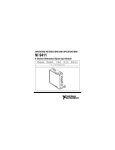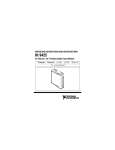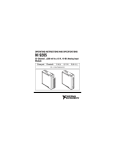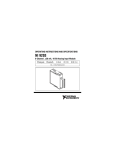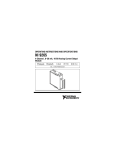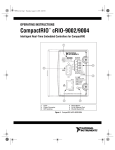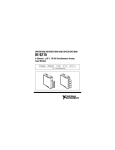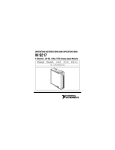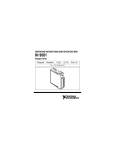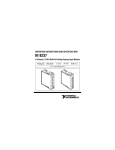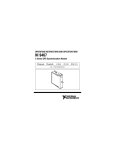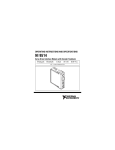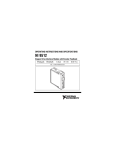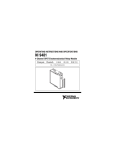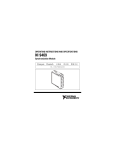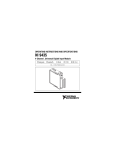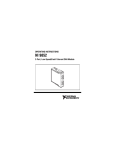Download NI 9211 Operating Instructions and Specifications
Transcript
OPERATING INSTRUCTIONS AND SPECIFICATIONS NI 9211 4-Channel Thermocouple Input Module Français Deutsch ni.com/manuals This document describes how to use the National Instruments 9211 and includes specifications and terminal assignments for the NI 9211. Visit ni.com/info and enter rdsoftwareversion to determine which software you need for the modules you are using. For information about installing, configuring, and programming the system, refer to the system documentation. Visit ni.com/info and enter cseriesdoc for information about C Series documentation. Note The safety guidelines and specifications in this document are specific to the NI 9211. The other components in the system might not meet the same safety ratings and specifications. Refer to the documentation for each component in the system to determine the safety ratings and specifications for the entire system. Visit ni.com/info and enter cseriesdoc for information about C Series documentation. Safety Guidelines Operate the NI 9211 only as described in these operating instructions. Hot Surface This icon denotes that the component may be hot. Touching this component may result in bodily injury. NI 9211 Operating Instructions and Specifications 2 ni.com Safety Guidelines for Hazardous Voltages If hazardous voltages are connected to the module, take the following precautions. A hazardous voltage is a voltage greater than 42.4 Vpk or 60 VDC to earth ground. Ensure that hazardous voltage wiring is performed only by qualified personnel adhering to local electrical standards. Caution Caution Do not mix hazardous voltage circuits and human-accessible circuits on the same module. Make sure that devices and circuits connected to the module are properly insulated from human contact. Caution When module terminals are hazardous voltage LIVE (>42.4 Vpk/60 VDC), you must ensure that devices and circuits connected to the module are properly insulated from human contact. You must use the NI 9932 connector backshell kit to ensure that the terminals are not accessible. Caution © National Instruments Corp. 3 NI 9211 Operating Instructions and Specifications Figure 1 shows the NI 9932 connector backshell. Figure 1. NI 9932 Connector Backshell Safety Guidelines for Hazardous Locations The NI 9211 is suitable for use in Class I, Division 2, Groups A, B, C, D, T4 hazardous locations; Class I, Zone 2, AEx nC IIC T4, and Ex nC IIC T4 hazardous locations; and nonhazardous locations only. Follow these guidelines if you are installing the NI 9211 in a potentially explosive environment. Not following these guidelines may result in serious injury or death. NI 9211 Operating Instructions and Specifications 4 ni.com Caution Do not disconnect I/O-side wires or connectors unless power has been switched off or the area is known to be nonhazardous. Do not remove modules unless power has been switched off or the area is known to be nonhazardous. Caution Substitution of components may impair suitability for Class I, Division 2. Caution For Zone 2 applications, install the system in an enclosure rated to at least IP 54 as defined by IEC 60529 and EN 60529. Caution For Zone 2 applications, connected signals must be within the following limit: Caution Capacitance .......................... 0.2 F max © National Instruments Corp. 5 NI 9211 Operating Instructions and Specifications Special Conditions for Hazardous Locations Use in Europe This equipment has been evaluated as Ex nC IIC T4 equipment under DEMKO Certificate No. 03 ATEX 0324020X. Each module is marked II 3G and is suitable for use in Zone 2 hazardous locations, in ambient temperatures of –40 °C Ta 70 °C. If you are using the NI 9211 in Gas Group IIC hazardous locations, you must use the device in an NI chassis that has been evaluated as Ex nC IIC T4, EEx nC IIC T4, Ex nA IIC T4, or Ex nL IIC T4 equipment. NI 9211 Operating Instructions and Specifications 6 ni.com Electromagnetic Compatibility Guidelines This product was tested and complies with the regulatory requirements and limits for electromagnetic compatibility (EMC) as stated in the product specifications. These requirements and limits are designed to provide reasonable protection against harmful interference when the product is operated in its intended operational electromagnetic environment. There is no guarantee that interference will not occur in a particular installation. To minimize the potential for the product to cause interference to radio and television reception or to experience unacceptable performance degradation, install and use this product in strict accordance with the instructions in the product documentation. The following statements contain important information needed before installing and using this product: This product is intended for use in industrial locations. As a result, this product may cause interference if used in residential areas. Such use must be avoided unless the user takes special measures to reduce electromagnetic emissions to prevent interference to the reception of radio and television broadcasts. Caution © National Instruments Corp. 7 NI 9211 Operating Instructions and Specifications Emissions that exceed the regulatory requirements may occur when this product is connected to a test object. Caution Changes or modifications not expressly approved by National Instruments could void the user’s authority to operate the hardware under the local regulatory rules. Caution Special Guidelines for Marine Applications Some products are Lloyd’s Register (LR) Type Approved for marine (shipboard) applications. To verify Lloyd’s Register certification for a product, visit ni.com/certification and search for the LR certificate, or look for the Lloyd’s Register mark on the product label. In order to meet the EMC requirements for marine applications, install the product in a shielded enclosure with shielded and/or filtered power and input/output ports. In addition, take precautions when designing, selecting, and installing measurement probes and cables to ensure that the desired EMC performance is attained. Caution NI 9211 Operating Instructions and Specifications 8 ni.com Connecting the NI 9211 The NI 9211 has a 10-terminal, detachable screw-terminal connector that provides connections for 4 thermocouple channels. TC0+ TC0– TC1+ TC1– TC2+ TC2– TC3+ TC3– NC COM 0 1 2 3 4 5 6 7 8 9 Figure 2. NI 9211 Terminal Assignments © National Instruments Corp. 9 NI 9211 Operating Instructions and Specifications You can connect thermocouple input signals to the NI 9211. Connect the positive lead of the thermocouple to the TC+ terminal and the negative lead of the thermocouple to the TC– terminal. If you are unsure which of the thermocouple leads is positive and which is negative, check the thermocouple documentation or the thermocouple wire spool. If you are using shielded wiring, connect one end of the shield to the COM terminal. The COM terminal is internally connected to the isolated ground reference of the module. Refer to Figure 3 for an illustration of a typical shielding configuration. Shield TC+ Thermocouple TC– COM NI 9211 Figure 3. Connecting a Shielded Thermocouple Input Signal to the NI 9211 NI 9211 Operating Instructions and Specifications 10 ni.com You must use 2-wire ferrules to create a secure connection when connecting more than one wire to a single terminal on the NI 9211. Note The NI 9211 channels share a common ground isolated from other modules in the system. Each channel passes through a filter and then a 24-bit analog-to-digital converter (ADC) samples the channel. Each channel also has an open thermocouple detection (OTD) circuit, which consists of a current source between the TC and TC– terminals. If an open thermocouple is connected to the channel, the current source forces a full-scale voltage across the terminals. Refer to Figure 4 for an illustration of the circuitry for one channel of the NI 9211. Each channel has a resistor that produces an input impedance between the TC and COM terminals and between the TC– and COM terminals. The gain and offset errors resulting from the source impedance of connected thermocouples are negligible for most applications. Thermocouples with a higher lead resistance can introduce more significant errors. Refer to the Specifications section for more information about errors resulting from source impedance. © National Instruments Corp. 11 NI 9211 Operating Instructions and Specifications TC+ 10 MΩ 10 MΩ TC– COM Input Impedance Open Thermocouple Detection Current Filtered Differential Amplifier Isolated ADC NI 9211 Figure 4. Input Circuitry for One Channel of the NI 9211 NI 9211 Operating Instructions and Specifications 12 ni.com Wiring for High-Vibration Applications If an application is subject to high vibration, National Instruments recommends that you either use ferrules to terminate wires to the detachable screw-terminal connector or use the NI 9932 backshell kit to protect the connections. Refer to Figure 5 for an illustration of using ferrules. Refer to Figure 1 for an illustration of the NI 9932 connector backshell. Figure 5. 10-Terminal Detachable Screw-Terminal Connector with Ferrule © National Instruments Corp. 13 NI 9211 Operating Instructions and Specifications Temperature Measurement Accuracy Considerations Temperature measurement errors depend partly on the thermocouple type, the accuracy of the thermocouple, the temperature being measured, and the cold-junction temperature. Refer to the Temperature Measurement Accuracy section in the Specifications for the errors of each thermocouple type when connected to the NI 9211. The errors do not account for the accuracy of the thermocouple itself. For the best accuracy results, keep temperature gradients across NI 9211 terminals to a minimum. Refer to the Minimizing Thermal Gradients section for more information. Cold-Junction Temperature Measurement Accuracy Heat dissipated by adjacent modules or other nearby heat sources can cause errors in thermocouple measurements by heating up the NI 9211 terminals to a different temperature than the cold-junction compensation sensor. The thermal gradient across the terminals can cause the terminals of different channels to be at different temperatures, in which case the resulting measurement creates errors not only in absolute accuracy but also in the relative NI 9211 Operating Instructions and Specifications 14 ni.com accuracy between channels. Refer to the Specifications section for the cold-junction compensation accuracy specifications. Refer to the Temperature Measurement Accuracy section in the Specifications for the thermocouple accuracy specifications. Minimizing Thermal Gradients Thermal gradients can be caused by changes in the ambient air temperature near the front connector or by the thermocouple wire if it conducts heat or cold directly to the terminal junctions. For the best accuracy results, follow these guidelines for minimizing thermal gradients: • Use small-gauge thermocouple wire. Smaller wire transfers less heat to or from the terminal junction. • Run thermocouple wiring together near the screw-terminal connector to keep the wires at the same temperature. • Avoid running thermocouple wires near hot or cold objects. • If you connect any extension wires to thermocouple wires, use wires made of the same conductive material as the thermocouple wires. • Minimize adjacent heat sources and air flow across the terminals. © National Instruments Corp. 15 NI 9211 Operating Instructions and Specifications • Use the NI 9932 connector backshell kit shown in Figure 1. • Keep the ambient temperature as stable as possible. • Keep the module in a stable and consistent orientation. • Allow the thermal gradients to settle after a change in system power or in ambient temperature. A change in system power can happen when the system powers on, the system comes out of sleep mode, or you insert/remove modules. Using the Autozero Channel The NI 9211 has an internal autozero channel for measuring the offset error. If the ambient temperature of the NI 9211 is less than 15 °C or more than 35 °C, use this channel to read the offset error. Subtract the offset error from the data read from each NI 9211 thermocouple input channel. Refer to the software help for information about using the autozero channel. Visit ni.com/info and enter cseriesdoc for information about C Series documentation. NI 9211 Operating Instructions and Specifications 16 ni.com Sleep Mode This module supports a low-power sleep mode. Support for sleep mode at the system level depends on the chassis that the module is plugged into. Refer to the chassis manual for information about support for sleep mode. If the chassis supports sleep mode, refer to the software help for information about enabling sleep mode. Visit ni.com/info and enter cseriesdoc for information about C Series documentation. Typically, when a system is in sleep mode, you cannot communicate with the modules. In sleep mode, the system consumes minimal power and may dissipate less heat than it does in normal mode. Refer to the Specifications section for more information about power consumption and thermal dissipation. © National Instruments Corp. 17 NI 9211 Operating Instructions and Specifications Specifications The following specifications are typical for the range –40 to 70 °C unless otherwise noted. Accuracy within typical use can vary based on chassis, mounting parameters, other modules present in the system, and installed accessories. The input terminals of this device are not protected for electromagnetic interference. As a result, this device may experience reduced measurement accuracy or other temporary performance degradation when connected cables are routed in an environment with radiated or conducted radio frequency electromagnetic interference. To limit radiated emissions and to ensure that this device functions within specifications in its operational electromagnetic environment, take precautions when designing, selecting, and installing measurement probes and cables. Caution NI 9211 Operating Instructions and Specifications 18 ni.com Input Characteristics Number of channels.......................... 4 thermocouple channels, 1 internal autozero channel, 1 internal cold-junction compensation channel ADC resolution................................. 24 bits Type of ADC..................................... Delta-Sigma Sampling mode ................................. Scanned Voltage measurement range .............. ±80 mV Temperature measurement ranges .... Works over temperature ranges defined by NIST (J, K, T, E, N, B, R, S thermocouple types) Conversion time ................................ 70 ms per channel; 420 ms total for all channels including the autozero and cold-junction channels Common-mode voltage range Channel-to-COM........................ ±1.5 V COM-to-earth ground................. ±250 V © National Instruments Corp. 19 NI 9211 Operating Instructions and Specifications Common-mode rejection ratio (0 to 60 Hz) Channel-to-COM........................ 95 dB COM-to-earth ground 170 dB Input bandwidth (–3 dB)................... 15 Hz Noise rejection (at 50 and 60 Hz) ..... 85 dB min Overvoltage protection ..................... ±30 V between any input and COM Differential input impedance ............ 20 M Input current...................................... 50 nA Input noise ........................................ 1 Vrms Gain error.......................................... 0.05% max at 25 °C, 0.06% typ at –40 to 70 °C, 0.1% max at –40 to 70 °C Offset error (with autozero channel on)........................................ 15 V typ, 20 V max Gain error from source impedance.............................. Add 0.05 ppm per when source impedance >50 NI 9211 Operating Instructions and Specifications 20 ni.com Offset error from source impedance.............................. Add 0.05 V typ, 0.07 V max per when source impedance >50 Cold-junction compensation sensor accuracy 0 to 70 °C ................................... 0.6 °C typ, 1.3 °C max –40 to 70 °C ............................... 1.7 °C max MTBF ............................................... 633,012 hours at 25 °C; Bellcore Issue 2, Method 1, Case 3, Limited Part Stress Method Note Contact NI for Bellcore MTBF specifications at other temperatures or for MIL-HDBK-217F specifications. © National Instruments Corp. 21 NI 9211 Operating Instructions and Specifications Temperature Measurement Accuracy Measurement sensitivity1 With autozero channel on Types J, K, T, E, N ............... <0.07 °C Types B ................................ <0.25 °C Types R, S ............................ <0.60 °C With autozero channel off Types J, K, T, E, N ............... <0.05 °C Type B .................................. <0.20 °C Types R, S ............................ <0.45 °C 1 Measurement sensitivity represents the smallest change in temperature that a sensor can detect. It is a function of noise. The values assume the full measurement range of the standard thermocouple sensor according to ASTM E230-87. NI 9211 Operating Instructions and Specifications 22 ni.com Figures 6, 7, 8, 9, and 10 show the typical and maximum errors for each thermocouple type when used with the NI 9211 over the full temperature range. The figures also display the maximum errors for the thermocouple types with the NI 9211 at room temperature, which is 15 to 35 °C. The figures account for gain errors, offset errors, differential and integral nonlinearity, quantization errors, noise errors, and isothermal errors. The figures do not account for the accuracy of the thermocouple itself. © National Instruments Corp. 23 NI 9211 Operating Instructions and Specifications Measurement Error (°C) 4 3 2 1 0 –200 0 200 400 600 800 Measured Temperature (°C) Max (Autozero on), –40 to 70 °C Typ (Autozero on), –40 to 70 °C 1000 1200 Max (Autozero off), room temp Figure 6. Thermocouple Type J and N Errors NI 9211 Operating Instructions and Specifications 24 ni.com Measurement Error (°C) 4 3 2 1 0 –200 0 200 400 600 800 1000 Measured Temperature (°C) Max (Autozero on), –40 to 70 °C Typ (Autozero on), –40 to 70 °C 1200 Max (Autozero off), room temp Figure 7. Thermocouple Type K Errors © National Instruments Corp. 25 NI 9211 Operating Instructions and Specifications Measurement Error (°C) 4 3 2 1 0 –200 0 200 600 400 Measured Temperature (°C) Max (Autozero on), –40 to 70 °C Typ (Autozero on), –40 to 70 °C 800 1000 Max (Autozero off), room temp Figure 8. Thermocouple Type T and E Errors NI 9211 Operating Instructions and Specifications 26 ni.com Measurement Error (°C) 6 4 2 0 200 400 600 800 1000 1200 1400 Measured Temperature (°C) Max (Autozero on), –40 to 70 °C Typ (Autozero on), –40 to 70 °C 1600 1800 Max (Autozero off), room temp Figure 9. Thermocouple Type B Errors © National Instruments Corp. 27 NI 9211 Operating Instructions and Specifications Measurement Error (°C) 6 4 2 0 –200 0 200 400 600 800 1000 1200 1400 1600 Measured Temperature (°C) Max (Autozero on), –40 to 70 °C Typ (Autozero on), –40 to 70 °C Max (Autozero off), room temp Figure 10. Thermocouple Type R and S Errors NI 9211 Operating Instructions and Specifications 28 ni.com Power Requirements Power consumption from chassis Active mode ............................... 170 mW max Sleep mode ................................. 4 mW max Thermal dissipation (at 70 °C) Active mode ............................... 170 mW max Sleep mode ................................. 4 mW max Physical Characteristics If you need to clean the module, wipe it with a dry towel. Note For two-dimensional drawings and three-dimensional models of the C Series module and connectors, visit ni.com/dimensions and search by module number. Screw-terminal wiring ...................... 12 to 24 AWG copper conductor wire with 7 mm (0.28 in.) of insulation stripped from the end Torque for screw terminals ............... 0.5 to 0.6 N · m (4.4 to 5.3 lb · in.) © National Instruments Corp. 29 NI 9211 Operating Instructions and Specifications Ferrules ............................................. 0.25 mm2 to 2.5 mm2 Weight............................................... 150 g (5.3 oz) Safety Safety Voltages Connect only voltages that are within the following limits. Channel-to-COM 30 V max Isolation Channel-to-channel .................... None Channel-to-earth ground Continuous ........................... 250 Vrms, Measurement Category II Withstand ............................. 2,300 Vrms, verified by a 5 s dielectric withstand test Measurement Category II is for measurements performed on circuits directly connected to the electrical distribution system. This category refers to local-level electrical distribution, such as that provided by a standard wall outlet, for example, 115 V for U.S. or 230 V for Europe. NI 9211 Operating Instructions and Specifications 30 ni.com Caution Do not connect the NI 9211 to signals or use for measurements within Measurement Categories III or IV. Hazardous Locations U.S. (UL) .......................................... Class I, Division 2, Groups A, B, C, D, T4; Class I, Zone 2, AEx nC IIC T4 Canada (C-UL) ................................. Class I, Division 2, Groups A, B, C, D, T4; Class I, Zone 2, Ex nC IIC T4 Europe (DEMKO)............................. Ex nC IIC T4 Safety Standards This product meets the requirements of the following standards of safety for electrical equipment for measurement, control, and laboratory use: • IEC 61010-1, EN 61010-1 • UL 61010-1, CSA 61010-1 © National Instruments Corp. 31 NI 9211 Operating Instructions and Specifications Note For UL and other safety certifications, refer to the product label or the Online Product Certification section. Electromagnetic Compatibility This product meets the requirements of the following EMC standards for electrical equipment for measurement, control, and laboratory use: • EN 61326-2-1 (IEC 61326-2-1): Class A emissions; Industrial immunity • EN 55011 (CISPR 11): Group 1, Class A emissions • AS/NZS CISPR 11: Group 1, Class A emissions • FCC 47 CFR Part 15B: Class A emissions • ICES-001: Class A emissions For EMC compliance, operate this device with shielded cables. Caution Note For the standards applied to assess the EMC of this product, refer to the Online Product Certification section. NI 9211 Operating Instructions and Specifications 32 ni.com CE Compliance This product meets the essential requirements of applicable European directives as follows: • 2006/95/EC; Low-Voltage Directive (safety) • 2004/108/EC; Electromagnetic Compatibility Directive (EMC) Online Product Certification To obtain product certifications and the Declaration of Conformity (DoC) for this product, visit ni.com/certification, search by module number or product line, and click the appropriate link in the Certification column. © National Instruments Corp. 33 NI 9211 Operating Instructions and Specifications Shock and Vibration To meet these specifications, you must panel mount the system and either affix ferrules to the ends of the terminal wires or use the NI 9932 backshell kit to protect the connections. Operating vibration Random (IEC 60068-2-64)......... 5 grms, 10 to 500 Hz Sinusoidal (IEC 60068-2-6) ....... 5 g, 10 to 500 Hz Operating shock (IEC 60068-2-27).............................. 30 g, 11 ms half sine, 50 g, 3 ms half sine, 18 shocks at 6 orientations Environmental National Instruments C Series modules are intended for indoor use only but may be used outdoors if installed in a suitable enclosure. Refer to the manual for the chassis you are using for more information about meeting these specifications. Operating temperature (IEC 60068-2-1, IEC 60068-2-2) ..... –40 to 70 °C Storage temperature (IEC 60068-2-1, IEC 60068-2-2) ..... –40 to 85 °C NI 9211 Operating Instructions and Specifications 34 ni.com Ingress protection.............................. IP 40 Operating humidity (IEC 60068-2-56).............................. 10 to 90% RH, noncondensing Storage humidity (IEC 60068-2-56).............................. 5 to 95% RH, noncondensing Maximum altitude............................. 2,000 m Pollution Degree ............................... 2 Environmental Management NI is committed to designing and manufacturing products in an environmentally responsible manner. NI recognizes that eliminating certain hazardous substances from our products is beneficial to the environment and to NI customers. For additional environmental information, refer to the NI and the Environment Web page at ni.com/environment. This page contains the environmental regulations and directives with which NI complies, as well as other environmental information not included in this document. © National Instruments Corp. 35 NI 9211 Operating Instructions and Specifications Waste Electrical and Electronic Equipment (WEEE) At the end of the product life cycle, all products must be sent to a WEEE recycling center. For more information about WEEE recycling centers, National Instruments WEEE initiatives, and compliance with WEEE Directive 2002/96/EC on Waste and Electronic Equipment, visit ni.com/environment/ weee. EU Customers ⬉ᄤֵᙃѻક∵ᶧࠊㅵ⧚ࡲ⊩ ˄Ё RoHS˅ Ёᅶ᠋ National Instruments ヺড়Ё⬉ᄤֵᙃ ѻકЁ䰤ࠊՓ⫼ᶤѯ᳝ᆇ⠽䋼ᣛҸ (RoHS)DŽ݇Ѣ National Instruments Ё RoHS ড়㾘ᗻֵᙃˈ䇋ⱏᔩ ni.com/environment/rohs_chinaDŽ (For information about China RoHS compliance, go to ni.com/ environment/rohs_china.) Calibration You can obtain the calibration certificate and information about calibration services for the NI 9211 at ni.com/calibration. Calibration interval ........................... 1 year NI 9211 Operating Instructions and Specifications 36 ni.com Where to Go for Support The National Instruments Web site is your complete resource for technical support. At ni.com/support you have access to everything from troubleshooting and application development self-help resources to email and phone assistance from NI Application Engineers. National Instruments corporate headquarters is located at 11500 North Mopac Expressway, Austin, Texas, 78759-3504. National Instruments also has offices located around the world to help address your support needs. For telephone support in the United States, create your service request at ni.com/support and follow the calling instructions or dial 512 795 8248. For telephone support outside the United States, contact your local branch office: Australia 1800 300 800, Austria 43 662 457990-0, Belgium 32 (0) 2 757 0020, Brazil 55 11 3262 3599, Canada 800 433 3488, China 86 21 5050 9800, Czech Republic 420 224 235 774, Denmark 45 45 76 26 00, Finland 358 (0) 9 725 72511, France 01 57 66 24 24, Germany 49 89 7413130, India 91 80 41190000, Israel 972 3 6393737, Italy 39 02 41309277, Japan 0120-527196, © National Instruments Corp. 37 NI 9211 Operating Instructions and Specifications Korea 82 02 3451 3400, Lebanon 961 (0) 1 33 28 28, Malaysia 1800 887710, Mexico 01 800 010 0793, Netherlands 31 (0) 348 433 466, New Zealand 0800 553 322, Norway 47 (0) 66 90 76 60, Poland 48 22 328 90 10, Portugal 351 210 311 210, Russia 7 495 783 6851, Singapore 1800 226 5886, Slovenia 386 3 425 42 00, South Africa 27 0 11 805 8197, Spain 34 91 640 0085, Sweden 46 (0) 8 587 895 00, Switzerland 41 56 2005151, Taiwan 886 02 2377 2222, Thailand 662 278 6777, Turkey 90 212 279 3031, United Kingdom 44 (0) 1635 523545 NI 9211 Operating Instructions and Specifications 38 ni.com LabVIEW, National Instruments, NI, ni.com, the National Instruments corporate logo, and the Eagle logo are trademarks of National Instruments Corporation. Refer to the Trademark Information at ni.com/trademarks for other National Instruments trademarks. Other product and company names mentioned herein are trademarks or trade names of their respective companies. For patents covering National Instruments products/technology, refer to the appropriate location: Help»Patents in your software, the patents.txt file on your media, or the National Instruments Patent Notice at ni.com/patents. © 2003–2010 National Instruments Corp. All rights reserved. 373466E-01 Oct10







































